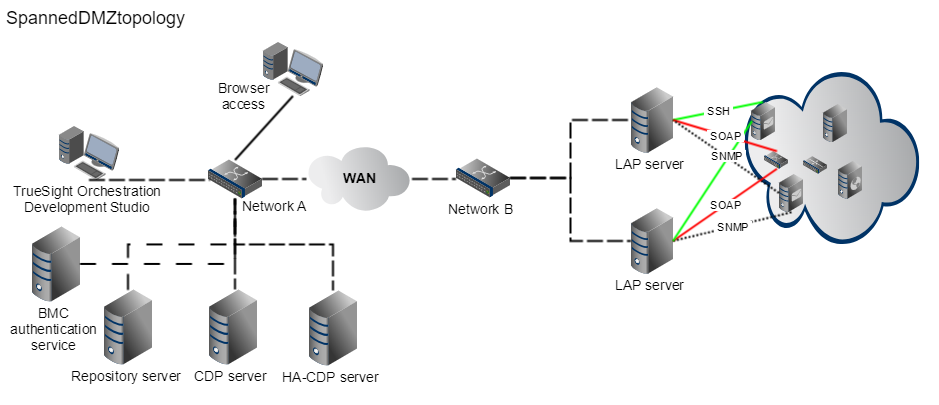Spanned DMZ deployment
This deployment configuration provides adapter access to systems in a sub-network, or DMZ, while minimizing the impact to the DMZ firewall rules. The grid is deployed in a high-availability configuration to provide redundancy for the processing peers. Inside the DMZ, lightweight activity peers (LAPs) are then co-located with the systems to be managed.
Dual LAP deployment increases the availability of the LAPs and enables redundancy for configured adapters. Any latency that results from the CDPs being separated from LAPs by a WAN would be handled by the peer's ability to adjust to network tolerance violations.
If applications and servers in a network address translation (NAT) device wish to initiate jobs on the CDPs through SOAP-based web service calls, a proxy server can route these requests to the CDPs, minimizing the impact to the DMZ firewall rules.

Naming convention for Platform components
The default naming convention usually includes CDP, HA-CDP, and so on. Occasionally, LAPs have a geographic reference such as airport codes; for example, LHR = London, Heathrow, HKG = Hong Kong, or DFW = Dallas.
Examples of a typical names: PRODCDP, PRODHACDP, LAPLHR1, LAPLHR2, LAPHKG1, LAPHKG2, LAPDFW1, and LAPDFW2.
To prepare for this deployment, review Installing an authentication service to plan your authentication service approach and complete the following worksheets:
Network A worksheets:
Repository installation worksheet
CDP installation worksheet
HA-CDP installation worksheet
Development Studio installation worksheet
Network B worksheets:
LAP installation worksheet
Related topics
System requirements
Adding adapters to a grid
Configuring adapters
Enabling and disabling adapters
Comments
Log in or register to comment.